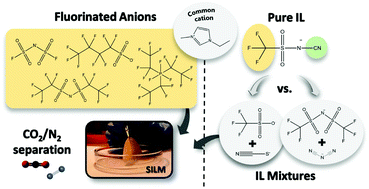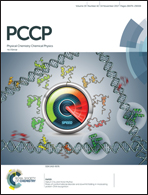Exploring the effect of fluorinated anions on the CO2/N2 separation of supported ionic liquid membranes†
Abstract
The CO2 and N2 permeation properties of ionic liquids (ILs) based on the 1-ethyl-3-methylimidazolium cation ([C2mim]+) and different fluorinated anions, namely 2,2,2-trifluoromethylsulfonyl-N-cyanoamide ([TFSAM]−), bis(fluorosulfonyl) imide ([FSI]−), nonafluorobutanesulfonate ([C4F9SO3]−), tris(pentafluoroethyl)trifluorophosphate ([FAP]−), and bis(pentafluoroethylsulfonyl)imide ([BETI]−) anions, were measured using supported ionic liquid membranes (SILMs). The results show that pure ILs containing [TFSAM]− and [FSI]− anions present the highest CO2 permeabilities, 753 and 843 Barrer, as well as the greatest CO2/N2 permselectivities of 43.9 and 46.1, respectively, with CO2/N2 separation performances on top of or above the Robeson 2008 upper bound. The re-design of the [TFSAM]− anion by structural unfolding was investigated through the use of IL mixtures. The gas transport and CO2/N2 separation properties through a pure [C2mim][TFSAM] SILM are compared to those of two different binary IL mixtures containing fluorinated and cyano-functionalized groups in the anions. Although the use of IL mixtures is a promising strategy to tailor gas permeation through SILMs, the pure [C2mim][TFSAM] SILM displays higher CO2 permeability, diffusivity and solubility than the selected IL mixtures. Nevertheless, both the prepared mixtures present CO2 separation performances that are on top of or above the Robeson plot.



 Please wait while we load your content...
Please wait while we load your content...